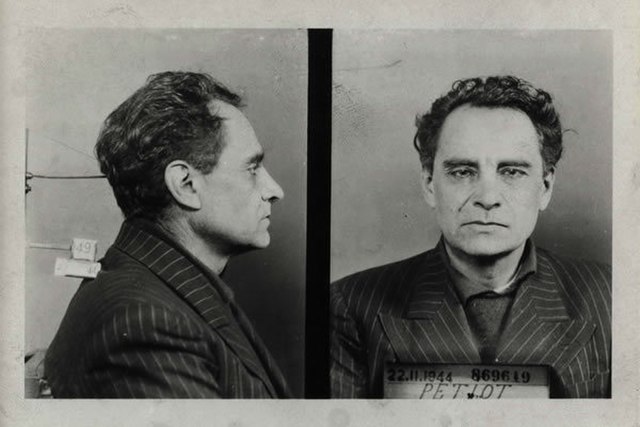Dr. Satan: The Terrifying French Serial Killer of World War II Paris
The dark and chaotic years of World War II provided a fertile ground for some of history’s most notorious criminals. Amidst the backdrop of Nazi occupation, resistance movements, and widespread suffering, one figure emerged as a particularly chilling embodiment of evil: Marcel Petiot, infamously known as **Dr. Satan**. A charismatic physician turned serial killer, Petiot exploited the desperation and fear of wartime Paris to commit heinous crimes that shocked the world. His story is a macabre tale of deception, greed, and murder, revealing the depths of human depravity during one of the darkest periods of the 20th century.
The Early Life of Marcel Petiot
Marcel André Henri Félix Petiot was born on January 17, 1897, in Auxerre, France. From an early age, he exhibited signs of intelligence and ambition, but also troubling behavior. As a child, he was known for his cruelty to animals and a penchant for lying. Despite these red flags, Petiot excelled academically and eventually pursued a career in medicine. He served as a soldier during World War I, where he was wounded and later accused of stealing from his fellow soldiers. This pattern of deceit and opportunism would define his life.
After the war, Petiot completed his medical studies and began practicing as a physician in the small town of Villeneuve-sur-Yonne. However, his career was marred by allegations of fraud, theft, and even murder. He was accused of poisoning patients and stealing their possessions, though he managed to evade serious consequences due to his cunning and charm. By the 1930s, Petiot had moved to Paris, where he established a medical practice and began to cultivate a reputation as a skilled and compassionate doctor.
The Rise of Dr. Satan
When World War II broke out and Nazi Germany occupied France in 1940, Paris became a city of fear and desperation. Jews, resistance fighters, and others targeted by the Nazis sought ways to escape the country. It was in this climate of terror that Marcel Petiot saw an opportunity to exploit the vulnerable.
Petiot began posing as a member of the French Resistance, offering to help people flee occupied France. He claimed to have connections with a secret network that could smuggle individuals to safety in Argentina or other neutral countries. His victims, many of whom were Jewish or political dissidents, paid exorbitant sums of money for his services, believing they were securing their freedom.
However, Petiot’s promises were a deadly ruse. He lured his victims to his home at 21 Rue Le Sueur, a luxurious townhouse in the affluent 16th arrondissement of Paris. There, he told them they would need to undergo medical examinations and vaccinations before their journey. Instead, he injected them with cyanide or other lethal substances, killing them almost instantly.
Petiot’s most lucrative activity, however, was his own false escape route, Fly-Tox. He adopted a “code-name” “Dr. Eugène.” He accepted anyone who could afford his price of 25,000 Francs per person regardless of whether they were Jews, resistance fighters, or ordinary criminals. His aides Raoul Fourrier, Edmond Pintard, and René-Gustave Nézondet directed victims to his hands.
Petiot claimed that he could arrange a safe passage to Argentina or elsewhere in South America through Portugal. He also claimed that Argentinean officials demanded inoculations and injected his victims with cyanide. Then he took all their valuables and disposed of the bodies. People who trusted him to deliver them to safety were never seen alive again.
At first Petiot dumped the bodies in the Seine, but he later destroyed the bodies by submerging them in quicklime or by incinerating them. In 1941, Petiot bought a house at 21 rue le Sueur.
What Petiot failed to do was to keep a low profile. The Gestapo eventually found out about him and, by April 1943, they had heard all about his “route.” Gestapo agent Robert Jodkum forced prisoner Yvan Dreyfus to approach the supposed network, but he simply vanished.
A later informer successfully infiltrated the operation and the Gestapo arrested Fourrier, Pintard, and Nézondet. Under torture they confessed that “Dr Eugène” was Marcel Petiot. Nezondet was later released but three others spent eight months in prison suspected of helping Jews to escape. Even under torture, they did not identify any other members of the resistance – because they actually knew of none. The Gestapo released the three men in January 1944.
The House of Horrors
The true extent of Petiot’s crimes came to light in March 1944, when neighbors reported a foul smell emanating from his townhouse. Firefighters were called to investigate, and what they discovered was nothing short of a nightmare.
In the basement of the house, authorities found a hidden chamber filled with quicklime, used to accelerate the decomposition of bodies. The remains of at least 27 victims were discovered, many of them dismembered and burned. The scene was so gruesome that it took weeks to identify the victims, and some bodies were never fully accounted for.
The investigation revealed that Petiot had meticulously planned his murders. He used his medical knowledge to dispose of the bodies efficiently, often dismembering them and burning the remains in a large stove. He also kept meticulous records of his victims’ possessions, which he sold or kept for himself. Among the items found in his home were jewelry, clothing, and even human teeth filled with gold.
The Darker Depths of Dr. Satan’s Crimes: Molestation and Abuse
While Marcel Petiot’s murders are the most well-documented aspect of his crimes, there is evidence to suggest that his depravity extended beyond killing. Reports and testimonies from the investigation into his activities hint at the possibility that Petiot may have subjected some of his victims to **sexual abuse, molestation, or other forms of physical and psychological torment** before their deaths. These allegations, though less thoroughly documented than his murders, paint an even more horrifying picture of a man who reveled in the suffering of others.
The Nature of the Allegations
During the investigation into Petiot’s crimes, authorities uncovered disturbing details about his methods. Some victims were reportedly stripped of their clothing before being killed, and there were signs that Petiot may have engaged in acts of **sexual violence** or humiliation. While forensic science in the 1940s was not as advanced as it is today, the condition of some of the bodies suggested that they had been subjected to **degrading treatment** prior to their deaths.
Additionally, Petiot’s background as a physician gave him a position of trust and authority, which he may have exploited to manipulate and abuse his victims. His medical practice provided him with access to vulnerable individuals, including women and young people, whom he could isolate and control. Some survivors of his schemes, who managed to escape before falling victim to his murderous plots, later recounted feeling uneasy or violated in his presence, though they could not always articulate why.
Psychological Torture and Manipulation
Beyond physical abuse, Petiot was a master of psychological manipulation. He preyed on the fears and desperation of his victims, many of whom were already traumatized by the horrors of war and Nazi persecution. By posing as a Resistance hero, he gained their trust, only to betray them in the most horrific ways.
For some victims, the psychological torment may have been as devastating as any physical abuse. Petiot reportedly enjoyed taunting his victims, leading them to believe they were moments away from freedom before revealing the true nature of their fate. This cruel psychological gamesmanship added an extra layer of suffering to his crimes, making him not just a murderer, but a sadist who derived pleasure from the anguish of others.
The Victims’ Stories
Among Petiot’s victims were women and young people who may have been targeted not only for their wealth or connections but also for their vulnerability. One particularly chilling account involves a young woman who sought Petiot’s help to escape Paris. According to testimonies, she was last seen entering his home, where she was allegedly subjected to **sexual assault** before being murdered. While concrete evidence of such acts is scarce due to the chaotic nature of the investigation and the destruction of evidence by Petiot himself, the patterns of his behavior suggest that these crimes were within the realm of possibility.
Another victim, a teenage boy who had fled Nazi persecution, was reportedly lured to Petiot’s home under the promise of safe passage out of France. Witnesses later recalled hearing screams coming from the townhouse, though they were too afraid to intervene. The boy’s body was never identified among the remains found at Rue Le Sueur, but his disappearance remains a haunting reminder of the potential for abuse in Petiot’s crimes.
The Manhunt and Trial
By the time authorities uncovered the horrors at Rue Le Sueur, Petiot had already fled. He went into hiding, using various aliases and disguises to evade capture. For several months, he managed to stay one step ahead of the police, even joining the French Resistance under a false name to further conceal his identity.
Petiot was finally arrested in October 1944, after being recognized by a former patient. His trial began in March 1946 and became a media sensation, drawing comparisons to the infamous Bluebeard legend. Petiot, ever the showman, used the trial as an opportunity to portray himself as a hero of the Resistance, claiming that his victims were Nazi collaborators and traitors. However, the evidence against him was overwhelming, and his defense quickly unraveled.
On May 25, 1946, Marcel Petiot was found guilty of 26 murders and sentenced to death. He was executed by guillotine on May 25, 1946, at the age of 49.
The Legacy of Dr. Satan
Marcel Petiot’s crimes remain one of the most horrifying chapters in the history of serial murder. His ability to exploit the desperation of wartime Paris, combined with his medical expertise and cunning, made him a uniquely terrifying figure. Estimates of his total number of victims range from 27 to over 60, though the exact number may never be known.
The allegations of molestation and abuse add a deeply disturbing dimension to Petiot’s legacy. While his murders alone are enough to cement his place as one of history’s most terrifying serial killers, the possibility that he also engaged in sexual violence underscores the sheer depravity of his actions.
Petiot’s story has inspired numerous books, films, and documentaries, cementing his place in the annals of true crime. His moniker, “Dr. Satan,” captures the essence of his evil: a man who used his intelligence and charm to prey on the vulnerable, leaving a trail of death and destruction in his wake.
Conclusion
The case of Marcel Petiot serves as a grim reminder of the darkness that can emerge in times of chaos and despair. It also highlights the importance of vigilance and justice, even in the face of overwhelming evil. Dr. Satan may be gone, but his legacy continues to haunt the collective memory of a world that witnessed the horrors of war and the monsters it created.
Petiot’s crimes—both his murders and the alleged abuse of his victims—stand as a testament to the depths of human depravity. His story is a chilling reminder that evil often wears a mask of normalcy, and that the most terrifying monsters are those who walk among us, hidden in plain sight.



